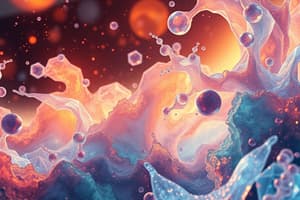Podcast
Questions and Answers
Which statement best describes pure substances?
Which statement best describes pure substances?
- They can be broken down into simpler substances by physical means.
- They have a fixed chemical composition and distinct properties. (correct)
- They can be physically separated into individual components.
- They are always homogeneous mixtures.
What distinguishes a compound from an element?
What distinguishes a compound from an element?
- Compounds consist of a single type of atom.
- Elements cannot be broken down into simpler substances by chemical means.
- Compounds are formed from two or more elements chemically combined. (correct)
- Elements can exist in different physical states.
Which of the following is an example of a homogeneous mixture?
Which of the following is an example of a homogeneous mixture?
- Oil and water
- Sand and water
- Saltwater (correct)
- A salad
What is a common property of mixtures?
What is a common property of mixtures?
Which separation technique would be most effective for separating a liquid from an insoluble solid?
Which separation technique would be most effective for separating a liquid from an insoluble solid?
Which characteristic is NOT typical of a pure substance?
Which characteristic is NOT typical of a pure substance?
What is true about heterogeneous mixtures?
What is true about heterogeneous mixtures?
Which of the following best defines an element?
Which of the following best defines an element?
Flashcards
What is matter?
What is matter?
Anything that has mass and occupies space.
Pure substances
Pure substances
Substances with a fixed chemical composition and distinct properties.
What are elements?
What are elements?
The simplest form of matter, composed of only one type of atom; cannot be broken down into simpler substances by chemical means.
What are compounds?
What are compounds?
Signup and view all the flashcards
What are mixtures?
What are mixtures?
Signup and view all the flashcards
What are homogeneous mixtures?
What are homogeneous mixtures?
Signup and view all the flashcards
What are heterogeneous mixtures?
What are heterogeneous mixtures?
Signup and view all the flashcards
How do you separate mixtures?
How do you separate mixtures?
Signup and view all the flashcards
Study Notes
Introduction to Pure Substances and Mixtures
- Matter is anything that has mass and occupies space.
- All matter can be classified as either pure substances or mixtures.
- Pure substances have a fixed chemical composition and distinct properties.
- Mixtures have a variable composition and properties.
Pure Substances
- Pure substances are further categorized into elements and compounds.
- Elements: The simplest form of matter; cannot be broken down into simpler substances by chemical means.
- Composed of only one type of atom.
- Examples: Hydrogen (H), Oxygen (O), Carbon (C), etc.
- Compounds: Substances formed from two or more elements chemically combined in a fixed ratio.
- Can be broken down into simpler substances by chemical means.
- Properties of a compound are different from the properties of the elements it's composed of.
- Examples: Water (H₂O), Carbon dioxide (CO₂), Sodium chloride (NaCl), etc.
- Identifying characteristics of pure substances:
- Constant composition: The constituent elements are always present in the same fixed proportion by mass.
- Fixed melting and boiling points: These points are unique and characteristic of the substance.
- Definite set of physical properties: Density, color, and other physical traits are constant.
Mixtures
- Mixtures are combinations of two or more pure substances that are not chemically bonded.
- Components in a mixture retain their individual properties.
- Mixtures can be:
- Homogeneous mixtures: Components are uniformly distributed throughout the mixture. Also known as solutions.
- Examples: Saltwater, air, sugar dissolved in water.
- Heterogeneous mixtures: Components are not uniformly distributed and distinct phases are visible.
- Examples: Sand and water, oil and water, a salad, a pizza.
- Homogeneous mixtures: Components are uniformly distributed throughout the mixture. Also known as solutions.
- Key characteristics of mixtures:
- Variable composition: The proportion of the components can vary.
- Variable melting and boiling points: The melting and boiling points of a mixture are not fixed.
- Retain properties of components: The individual components maintain their properties.
Separating Mixtures
- Techniques used to separate mixtures depend on the nature of the components.
- Decantation: Separating a liquid from a solid by carefully pouring off the liquid leaving the solid behind.
- Filtration: Separating a solid from a liquid using a filter.
- Evaporation: Separating a solid dissolved in a liquid by evaporating the liquid, leaving the solid behind.
- Distillation: Separating components of a liquid mixture based on their different boiling points.
- Chromatography: Separating components of a mixture based on their different affinities to a stationary and mobile phase.
Conclusion
- The matter around us is rarely found as a pure substance.
- Understanding the difference between pure substances and mixtures is crucial in various scientific fields, and essential for practical applications involving material separation and analysis.
Studying That Suits You
Use AI to generate personalized quizzes and flashcards to suit your learning preferences.




